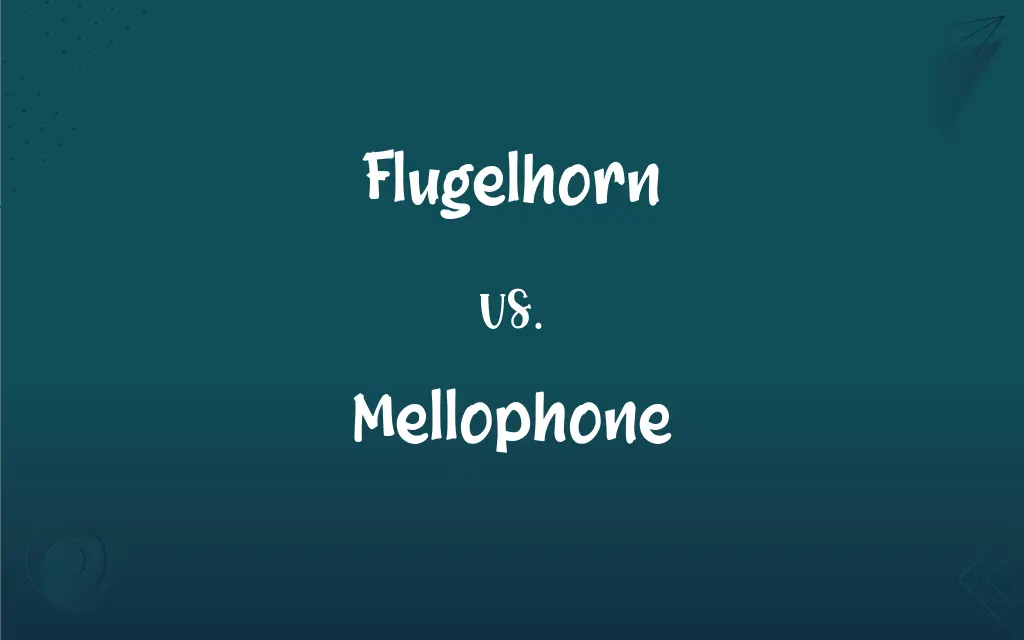Flugelhorn vs. Mellophone: What's the Difference?
By Janet White & Harlon Moss || Updated on May 22, 2024
The flugelhorn is a brass instrument similar to a trumpet but with a mellower tone, often used in jazz and brass bands, while the mellophone is a brass instrument used primarily in marching bands and similar to the French horn in sound.

Key Differences
The flugelhorn is a brass instrument that resembles a trumpet but has a wider, conical bore and a larger bell, which give it a softer, more mellow tone. It is commonly used in jazz, concert bands, and brass bands, adding a warm, lyrical quality to the ensemble. The mellophone, on the other hand, is a brass instrument specifically designed for marching bands and outdoor performances. It is similar to the French horn in terms of range and timbre but is constructed with a forward-facing bell and piston valves, which make it more practical for marching.
While both instruments serve different purposes within musical ensembles, the flugelhorn is prized for its smooth, mellow sound ideal for melodic lines, whereas the mellophone is valued for its ability to deliver a strong, clear sound suitable for marching bands. The construction and playing techniques of the flugelhorn align closely with the trumpet, while the mellophone is tailored to mimic the French horn’s tonal characteristics but with greater ease of play in marching contexts.
Comparison Chart
Shape and Bore
Conical bore, wide bell
Forward-facing bell, cylindrical bore
Sound Quality
Mellow, warm, lyrical
Bright, powerful, resonant
Common Use
Jazz, concert bands, brass bands
Marching bands, outdoor performances
ADVERTISEMENT
Similarity
Similar to trumpet
Similar to French horn
Valves
Piston valves
Piston or rotary valves
Playing Range
Same range as trumpet
Same range as French horn
Ease of Playing
Similar to trumpet, easy transition
Easier than French horn for marching
Flugelhorn and Mellophone Definitions
Flugelhorn
A brass instrument with a conical bore and wide bell, similar to a trumpet.
The flugelhorn's mellow tone added depth to the jazz ensemble.
ADVERTISEMENT
Mellophone
A brass instrument with a forward-facing bell, used primarily in marching bands.
The mellophone section played a crucial role in the marching band’s performance.
Flugelhorn
Commonly used in jazz and concert bands for its warm sound.
He switched from trumpet to flugelhorn for the ballad section.
Mellophone
Designed for outdoor use, offering a powerful and bright sound.
The mellophone’s clear tone cut through the noise of the parade.
Flugelhorn
Often used for melodic lines due to its lyrical quality.
The flugelhorn's smooth sound was perfect for the melody.
Mellophone
Similar in range and timbre to the French horn but more practical for marching.
The mellophone replaced the French horn in the marching band for easier playing.
Flugelhorn
Uses similar fingerings to the trumpet, making it easy for trumpet players to pick up.
She found it easy to transition from trumpet to flugelhorn.
Mellophone
Produces a resonant tone that projects well in outdoor settings.
The mellophone’s sound carried across the football field during the halftime show.
Flugelhorn
Plays in the same range as a trumpet but with a softer tone.
The flugelhorn solo was a highlight of the brass band's performance.
Mellophone
Utilizes piston or rotary valves for easier fingering while marching.
The mellophone’s valve system made it accessible for young players.
Flugelhorn
A bugle with valves, similar to the cornet but having a wider bore.
Mellophone
A brass wind instrument, similar to the French horn, often used in military or marching bands.
Flugelhorn
A brass instrument resembling a cornet but with a wider, conical bore, and usually with three valves, in the same B-flat pitch as many trumpets and cornets but with a more deeply conical mouthpiece than those. A bugle with valves.
Mellophone
A brass instrument frequently used in place of the French horn in marching bands and similar performance groups
Flugelhorn
A brass wind instrument resembling a cornet but with a wider bore, and having three valves.
Flugelhorn
A brass instrument resembling a cornet but with a wider bore
FAQs
What is a mellophone?
The mellophone is a brass instrument used primarily in marching bands, similar to the French horn but designed for ease of marching.
How does the sound of a flugelhorn differ from a trumpet?
The flugelhorn has a softer, warmer, and more lyrical sound compared to the brighter, sharper tone of a trumpet.
What is a flugelhorn?
The flugelhorn is a brass instrument similar to a trumpet but with a mellower tone and wider bell.
How does the mellophone differ from the French horn?
The mellophone has a forward-facing bell and piston valves, making it easier to play while marching, and produces a bright, powerful sound.
Can trumpet players easily switch to flugelhorn?
Yes, since the flugelhorn uses similar fingerings and has a similar range to the trumpet.
Can French horn players easily switch to mellophone?
Yes, because the mellophone is designed to mimic the French horn’s range and timbre but with easier mechanics for marching.
What genres of music commonly use the flugelhorn?
The flugelhorn is commonly used in jazz, concert bands, and brass bands.
What settings are mellophones typically used in?
Mellophones are typically used in marching bands and outdoor performances.
Is the mellophone used for melody or harmony in marching bands?
The mellophone can be used for both melody and harmony in marching bands.
Which instrument has a more robust sound for outdoor performances?
The mellophone has a more robust sound that projects well outdoors.
Is the flugelhorn primarily a melodic or harmonic instrument?
The flugelhorn is primarily used as a melodic instrument due to its lyrical tone.
Can the flugelhorn be used in classical music?
While less common, the flugelhorn can be used in classical music settings for specific timbral effects.
What is the key difference in construction between a flugelhorn and a mellophone?
The flugelhorn has a conical bore and wide bell, while the mellophone has a forward-facing bell and cylindrical bore.
What type of valves does a mellophone use?
The mellophone can use either piston or rotary valves.
Does the mellophone have a similar bore to the French horn?
No, the mellophone typically has a cylindrical bore which differs from the conical bore of the French horn.
Does the flugelhorn have a wider bore than the trumpet?
Yes, the flugelhorn has a wider, conical bore.
What type of valves does a flugelhorn use?
The flugelhorn typically uses piston valves.
Which instrument is easier to play while marching, flugelhorn or mellophone?
The mellophone is easier to play while marching.
Is the mellophone used in concert settings?
The mellophone is less commonly used in concert settings and is mainly for marching bands.
What is the primary advantage of the mellophone in marching bands?
The primary advantage is its forward-facing bell and ease of playing while marching, providing a clear, powerful sound suitable for outdoor performances.
About Author
Written by
Janet WhiteJanet White has been an esteemed writer and blogger for Difference Wiki. Holding a Master's degree in Science and Medical Journalism from the prestigious Boston University, she has consistently demonstrated her expertise and passion for her field. When she's not immersed in her work, Janet relishes her time exercising, delving into a good book, and cherishing moments with friends and family.
Co-written by
Harlon MossHarlon is a seasoned quality moderator and accomplished content writer for Difference Wiki. An alumnus of the prestigious University of California, he earned his degree in Computer Science. Leveraging his academic background, Harlon brings a meticulous and informed perspective to his work, ensuring content accuracy and excellence.































































